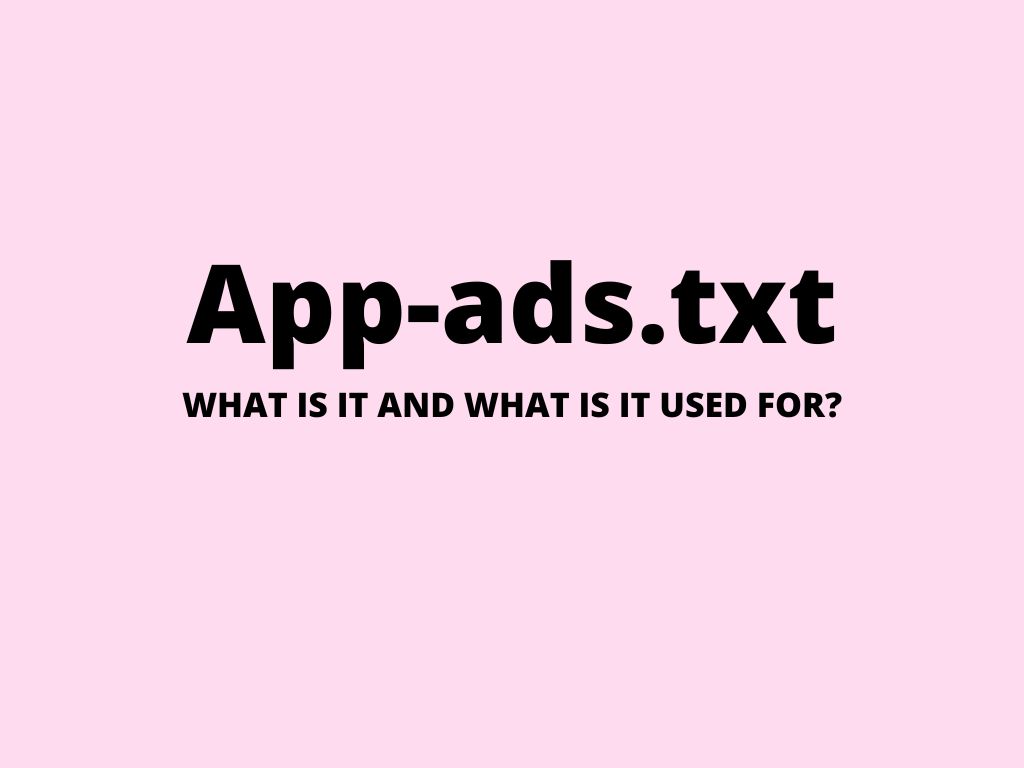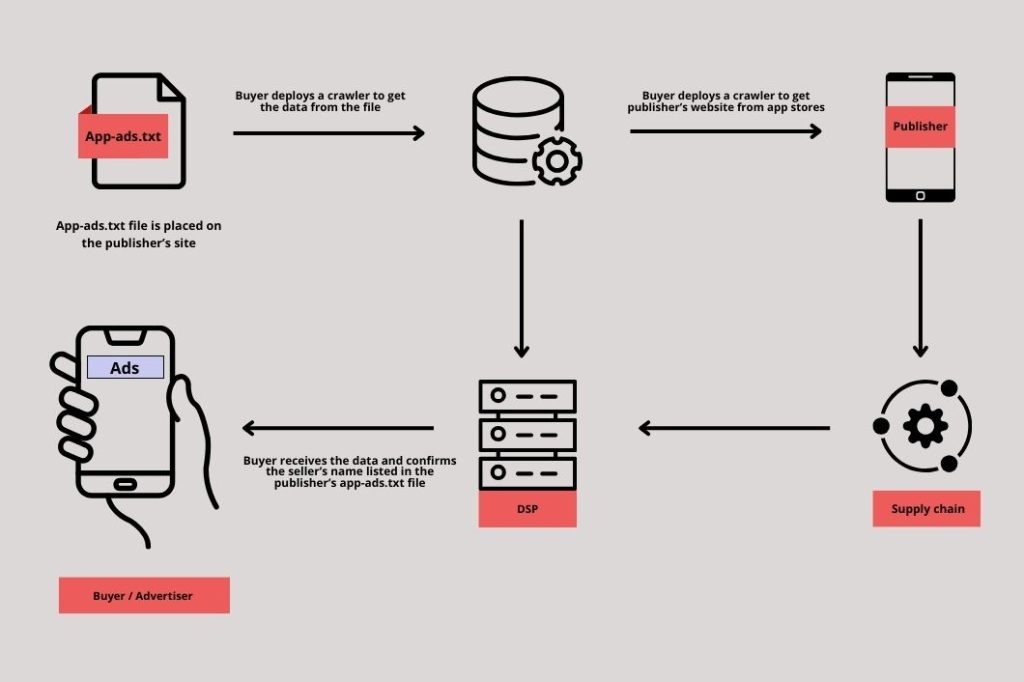
App-ads.txt – what is it and what is it used for?
App-ads.txt is a text file incorporated into developer websites by app developers and publishers. Its purpose is to enumerate the vendors authorized to sell their inventory. App-ads.txt serves as a crucial tool in addressing several challenges within the realm of programmatic advertising, notably tackling issues related to transparency and security that affect all participants in this ecosystem.
What is app-ads.txt?
App-ads.txt, formally known as Authorized Digital Sellers for Mobile Apps, serves as a valuable tool tailored for app developers and publishers. Its primary purpose is to grant authorization to specific ad networks and supply-side platforms (SSPs) for selling their digital ad inventory.
In simpler terms, it functions as a text file that comprehensively catalogs approved ad tech vendors who possess the rightful authorization to vend the publisher’s digital ad inventory.
The implementation process involves publishers uploading the app-ads.txt to their developer websites, enabling developers to crawl the developer website and evaluate the app-ads.txt file. Consequently, this assists them in making informed decisions when accepting bid requests from ad networks and supply-side platforms (SSPs) listed within the file.
To enhance transparency within the programmatic advertising landscape, the Interactive Advertising Bureau (IAB) Tech Lab introduced app-ads.txt in November 2018. This extension of the ads.txt file is specifically tailored for mobile in-app advertising and OTT advertising environments.
Due to the multitude of benefits it offers to both publishers and advertisers, various renowned app stores, including Google Play and the Apple App Store, have embraced and supported the utilization of app-ads.txt.
How does app-ads.txt work?
To implement app-ads.txt, mobile app developers take the following steps: they either upload the app-ads.txt file directly to their developer website or utilize online app-ads.txt hosting platforms for this purpose. Subsequently, they incorporate the URL of their developer website into each app store listing.
For buyers and advertisers, the process involves scanning individual app stores to pinpoint the developer’s website linked to a specific app of interest. Once the URL is obtained, advertisers can then proceed to inspect the developer’s website, identifying the authorized vendors entrusted with the responsibility of selling the publisher’s ad inventory. This information proves invaluable when they are tasked with the decision of accepting or declining bid requests from an ad network or SSP.

The top advantages of app-ads.txt
App-ads.txt serves a crucial role in preventing unauthorized sales of in-app advertising inventory, offering a range of benefits for both advertisers and publishers.
-
Enhanced security
App-ads.txt significantly contributes to improved security within the digital advertising landscape. While programmatic advertising is efficient and rapid, it often lacks direct communication channels between buyers, sellers, and ad tech vendors. This communication gap creates opportunities for malicious actors to engage in unauthorized inventory sales and generate counterfeit impressions.
Common issues associated with digital advertising include:
- Unauthorized reselling: Third-party resellers distribute ad inventory without providing proper seller information, leading to undervalued inventory and revenue losses for publishers.
- Counterfeit Inventory: Fraudulent ad tech vendors deceive buyers by falsely claiming access to inventory they are not authorized to sell, resulting in advertisers accepting bid requests for non-existent inventory.
- Domain spoofing: Malicious entities, such as fraudulent ad networks or SSPs, impersonate legitimate publishers’ apps and falsely offer their inventory for sale, diverting revenue from legitimate sellers and causing advertisers to invest in fraudulent inventory.
App-ads.txt plays a pivotal role in mitigating these risks. It ensures that advertisers exclusively accept bid requests from authorized and legitimate ad tech vendors with genuine access to the desired inventory within a publisher’s app. This enhancement bolsters the overall security of the programmatic advertising ecosystem.
Moreover, app-ads.txt empowers publishers by safeguarding their revenue from undervalued inventory and domain spoofing. It grants publishers full control over the selection of entities permitted to sell or resell their inventory, further solidifying their position in the advertising landscape.
-
Augmented transparency and trust
App-ads.txt bolsters transparency and trust within the advertising ecosystem. Advertisers gain the ability to authenticate the assertions of ad tech vendors by visiting the publisher’s developer website to verify access to their inventory. This heightened transparency simplifies the ad purchasing and bidding process.
Furthermore, in the eyes of contemporary advertisers, the presence of app-ads.txt signifies credibility and reliability. Publishers who provide this file on their developer website are more likely to earn the trust of advertisers.
-
Ensured brand safety
App-ads.txt guarantees that advertisers’ campaigns are exclusively displayed on legitimate and relevant advertisements, safeguarding their brand image. This assurance maximizes the likelihood of reaching their target audience effectively.
Conversely, publishers can be confident that malicious actors cannot replicate their apps or falsely claim access to their inventory without proper authorization. This protection reinforces publishers’ reputation and trustworthiness.
-
Amplified revenue
The proper implementation of app-ads.txt alleviates publishers’ concerns about revenue loss due to app plagiarism or counterfeit inventory. Publishers can capture every dollar spent by advertisers on their inventory.
Similarly, app-ads.txt reduces the risk for advertisers of falling victim to deceptive ad tech vendors, minimizing the loss of valuable advertising funds attributed to fake impressions and clicks. Consequently, it enhances campaign performance and facilitates higher returns on ad spend (RoAS).
App-ads.txt examples
The app-ads.txt file consists of various lines for different ad networks and SSPs. Each app-ads.txt record includes the following elements:
- Ad system domain
- Publisher account ID
- Account type/relationship
- Certificate authority ID
Here’s what an actual app-ads.txt record looks like:
google.com, pub-00000000000000000000, DIRECT, a03c45fec0942fa3
Let’s look into each element of app-ads.txt records in detail:
Ad system domain
The canonical domain name of the advertising system (or ad network) the buyer will use to access the publisher’s inventory. If, for example, a publisher wants to authorize Google’s ad network to sell their inventory, they can use “google.com” as the ad system domain.
Publisher account ID
A unique identifier associated with the publisher’s account or reseller account in the advertising system. “pub-00000000000000000000” is the publisher account ID in the example above.
Account type/relationship
Here, “DIRECT” shows that Google’s ad network will directly offer the publisher’s inventory to interested buyers and denotes the type of relationship the seller shares with the vendor. The publisher can list a vendor as “direct” or “reseller,” depending on whether the vendor uses third-party resellers for selling inventory.
Note: Publishers shouldn’t add any vendor to their app-ads.txt file until they or their partners have a connection with them.
Certificate authority ID
A unique ID that identifies the advertising system (or ad network) within a certification authority. “a03c45fec0942fa3” is the certificate authority ID in the example above.
App-ads.txt implementation
App-ads.txt is a user-friendly and straightforward tool, but its successful implementation is essential to maximize its benefits for advertisers and publishers.
To begin, registering a domain name and hosting the developer’s website are prerequisites for implementing the file. Additionally, developers and publishers must be meticulous in naming the .txt file to avoid errors.
Here is an overview of the steps involved in app-ads.txt implementation:
- The developer includes their website URL in every app store listing.
- The publisher contacts various vendors, including ad networks and SSPs, to request their app-ads.txt records in the following format: ad system domain, publisher ID, account type/relationship, and certificate authority ID.
- The publisher uses a text editor like Notepad to create a file that lists individual app-ads.txt records received from different vendors. Each record is typically entered on a new line. They save the file with the name “app-ads.txt.”
- The developer uploads the file to their root domain, resulting in a URL like “https://example.com/app-ads.txt.”
Publishers can refer to the IAB guidelines for more detailed information on creating and implementing app-ads.txt.
Key information about the term “app-ads.txt” to remember
- App-ads.txt is a straightforward tool developed by the IAB with the aim of combating ad fraud and enhancing transparency within the realms of mobile in-app and OTT advertising. It extends the advantages of ads.txt into these domains.
- This tool consists of a comprehensive roster of authorized ad networks and SSPs responsible for selling a publisher’s app inventory. The file is hosted on the respective developer’s website, serving as a reference for advertisers when deciding whether to accept or decline bid requests from a given vendor.
- Implementing app-ads.txt effectively yields the following advantages:
-
- Enhanced transparency and trust – app-ads.txt fosters a more transparent and trustworthy environment for programmatic advertising.
- Reduced risk of counterfeit inventory and domain spoofing – it mitigates the likelihood of counterfeit inventory and domain spoofing, enhancing security for all stakeholders.
- Minimal loss of advertising revenue – unauthorized reselling is curtailed, resulting in minimal loss of advertising revenue.
- Improved ROI for advertisers – advertisers benefit from a more reliable ecosystem, leading to an improved return on investment.
- Guaranteed brand safety – advertisers can be confident in the brand safety provided by app-ads.txt.
- For publishers and developers, meticulous adherence to the correct format of each record is essential. This diligence ensures that both publishers and advertisers can fully capitalize on the advantages offered by programmatic advertising.
Was this article helpful?
Support us to keep up the good work and to provide you even better content. Your donations will be used to help students get access to quality content for free and pay our contributors’ salaries, who work hard to create this website content! Thank you for all your support!
Reaction to comment: Cancel reply